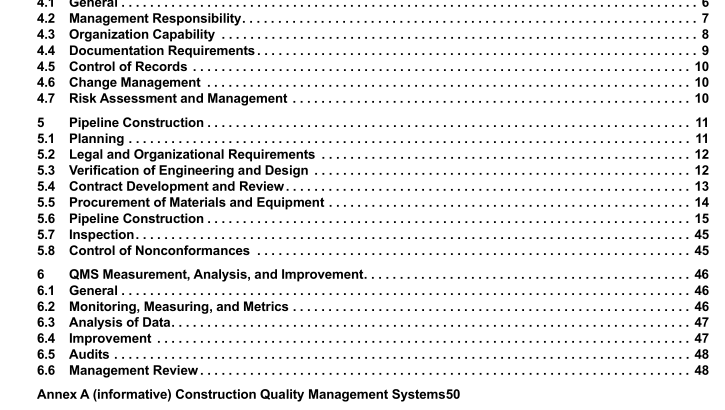API RP 1177:2017 pdf free download.Recommended Practice for Steel Pipeline Construction Quality Management Systems
5.6.18.2 Quality Concerns for Buoyancy Control
The buoyancy control procedure should include controls to promote quality by minimizing the likelihood of:
— pipe or coating damage due to improper installation procedures;
— pipe coating damage due to application of buoyancy control methods;
— insufficient weighting or failure of the weighting mechanism, leading to pipe rising or shifting;
— unstable substrate resulting in differential settlement or buckling;
— insufficient spacing of buoyancy control methods, resulting in pipe rising or localized deformation; and
— unidentified environmental conditions along the ROW.
5.6.18.3 Quality Assurance/Quality Control for Buoyancy Control AQP requirements for buoyancy control should include:
— confirmation of proper ditch depth;
— adherence to procedure parameters in the field;
— confirmation of the suitability of the buoyancy control design for the ROW environment;
— installation of protective material under buoyancy control methods to prevent coating damage;
— confirmation of concrete coating thickness;
— pull-testing of anchor-type buoyancy controls;
— documentation of type and locations of buoyancy control methods used (as-builts); and
— controls to ensure appropriate pipe and coating repair procedures are used.
5.6.19.1 General
The organization shall maintain a procedure for as-built surveying. The position and unique identification of each system component shall be documented.
NOTE As-built surveying is coordinated with as-built documentation, including GIS input, if applicable, in which the survey results and associated component and test documentation are tied into a completed as-built package. An accurate and properly documented as-built package of a completed pipeline is required for verifiable, traceable, and complete records. The process of creating an as-built package typically starts as soon as pipeline construction begins and is carried out on a daily basis. This process involves recording each day’s construction activities, including the installation of each joint of pipe and piping component (e.g. valves, flanges, tees, elbows, etc.).
The data that shall be collected as part of the as-built survey process is:
a) the amount, location, and cover over each pipe/component installed;
b) the location of each crossing of another pipeline;
c) the location of each buried utility crossing;
d) the location of each overhead crossing; and
e) the location of each valve and corrosion test station.
Additional data that should be considered for collection as part of the as-built survey process is as follows:
— each pipe/component location and associated attributes, including:
— elevation;
— location of the upstream and downstream girth welds;
— pipe protection type (such as rock shield), as applicable;
— trench breakers, as applicable; and
— buoyancy control method (such as weights or concrete coating), as applicable;
— each girth weld location, including:
— location coordinates of welds and appurtenances (preferably compatible for GIS);
— girth weld identifier, welder identification, and NDE report number; and
— type of weld (mainline, tie-in, final tie-in, etc.);
— each component (e.g. valve, bend, fitting, tee), corrosion test station, anode, and appurtenance (e.g.support) location and associated attributes:
— coordinate locations of components, anodes, and appurtenances;
— bend angle, direction (e.g. vertical, horizontal), and type of bend (field, induction, elbow); and
— component identifier (to tie back to design attributes, MTR, and associated test documentation);
and
— additional construction information, including:
— terrain and soil conditions;
— land usage;
— locations of non-native backfill materials;
— final HDD profiles;
— locations of any above- or below-ground structures within the ROW; and
— pipeline above-ground markers (AGM).
5.6.19.2 Quality Concerns for As-built Surveying
The as-built surveying procedure should include controls to promote quality by minimizing the likelihood of:
— data not recorded in a timely fashion during construction;
— data not recorded prior to burial or pull-back;
— poor data alignment and quality;
— missing data;
— inaccurate data;
— data loss after collection; and
— improper communication of construction timing and/or activity changes.
5.6.19.3 Quality Assurance/Quality Control for As-built Surveying
AQP requirements for as-built surveying should include:
— proper use and calibration of data collection equipment;
— regular QC of collected data to verify accuracy of pipe/component attributes and locations;
— routine backup of collected data; and
— QC of input of locations and data into GIS database.API RP 1177 pdf download.API RP 1177:2017 pdf free download
